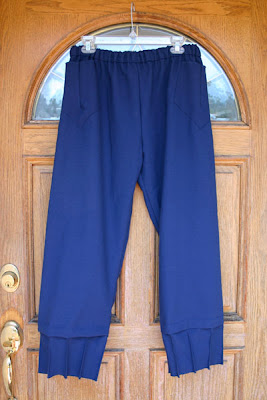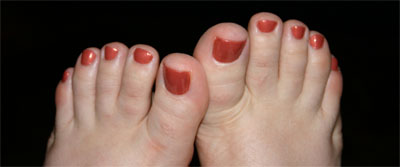
Buying fabric online has its inherent risks, but I mostly have been happy with my internet purchases. I like great denims, and when I saw this reversible denim on Gorgeous Fabrics, I loved it. It was called Reversible Soleil Denim, a perfect name for the stylized suns on the reverse side of the fabric and I had several jacket/coat ideas for it.
I bought the fabric, well before Christmas, on sale. When it arrived, I was a bit surprised how thick and stiff it was. The description on the website didn't clue me in. Think of the stiffest pair of jeans you have ever struggled to hem.
This denim is stiffer.

I have never before seen, or sewn, denim as stiff as this. But, it is gorgeous. :)
For several weeks, I threw the fabric into every dark load of laundry. I washed and dried it at least ten times. I abused it at much as possible, by throwing in tennis shoes, for example, but any softening was negligible. This denim wouldn't work for the designs I had in mind so, after showing it to a couple of friends, I reluctantly put it away.
One friend had mentioned she thought it might be a suitable fabric for the Haiku or Haiku Two jacket, from Sewing Workshop. That wasn't how I envisioned the project, so I forgot about it. When I recently unearthed it, I was determined to use it for a jacket of some sort. (I really need jackets!) I went through all of my patterns and, wouldn't you know, I decided to use the Haiku pattern, largely because it would feature the wonderful reverse side on the lapel. I guess she was right, after all. :)
The Haiku Jacket is officially out of print, but copies are still available through independent sellers, such as Vogue Fabric Store, and it shows up occasionally on ebay. The reason I chose the Haiku, instead of the Haiku Two (which I also own and is still in print), is because it is longer and less flared – it had more of the silhouette I wanted.
This is an older Sewing Workshop pattern, meaning the sizing is very generous. It is difficult to measure the flat pattern, but I was pretty sure that the small would work for me, so I made a muslin of the small. Other than being a tad long (which I decided to leave as-is), the Small was a perfect fit. In the Big 4 patterns, I generally wear an 18 or 20 on top, and usually add an FBA, so a Small (without FBA or any alterations) is generous indeed. And how rare is it for me to make something out of the envelope without any alterations at all???!! Pretty nice. :)
While this isn't a hard pattern to sew, exactly, it uses flat felled seams throughout, which was a challenge in this stiff fabric. However, the flat fell seam was an appropriate finish for denim, so that is what I used. Anyone who has sewn much with Sewing Workshop patterns is familiar with their wide hems made using oak tag templates and their generous use of mitered corners. This pattern was created before those techniques were adopted, but I used them anyway. The miters were especially important to minimize bulk in this very dense fabric and I used them on the bottom of the pockets, as well as on the bottom of the back facing.
The changes I made were minimal:
- I omitted all interfacings (not needed!)
- I omitted the rectangular reinforcements sewn on the inside at the top of the pockets.
- I sewed the sleeve facings on inside out, so when I roll back the cuffs, you will see the reverse of the fabric.
Trying to sew seams that went across flat felled seams involved many layers of the thick denim. This is a good time to get out one of those "hump jumpers" or "thing-a-ma-jigs", if you have one, which I don't. When my presser foot was in the air, going over these thick spots, I folded a denim remnant several times and placed it behind and under the presser foot. A much cheaper, and more convenient, solution. I also made heavy use of my tailor's clapper during construction to tame the fabric, which was fairly resistant to laying flat when pressed. I was hoping to complete the jacket without breaking any sewing machine needles but, towards the end, when I was sewing the very challenging flat fell seam along the shoulder/top of sleeve (which is the last flat fell seam I had to sew), I broke the needle when going over many layers of the denim. Though I only lost one machine needle, many straight pins died in the construction of this jacket.

Detail on the inside, showing some of the flat fell seams and the sleeve facing.
Even before hemming the jacket, which I did early in the process of construction, I realized that the design was going to expose a bit of the solid blue denim at the bottom of the turned back lapel. I saw a few possible solutions to this problem, none of which excited me:
- Hem normally, causing the blue to show at the bottom of the lapels.
- Hem in the reverse direction, causing the suns to show at the bottom of the jacket, all the way around (except at the lapels).
- Bind the hem, which still presents the artifacts of the first two solutions, depending on which side of the fabric the binding uses.
- Don't hem the jacket, but use a zigzag or serged edge. (Though my serger is currently capable only of the regular overlock stitch.)
- Where the lapel folds back, change the direction of the hem. This didn't thrill me either, since I would have to slice the denim the width of the hem – it wouldn't be a clean finish.
After due consideration, I used the first option, but I am not loving that bit of solid blue that shows at the bottom of the lapels. Do any of you have a better suggestion? I even considered hand tacking on a bit of the "sun" fabric to cover up the solid blue - sort of a informal applique. When I looked through the Haiku gallery on the Sewing Workshop page, looking for other possible solutions, I realized that the posted samples either used a fabric where the front and back are virtually the same, or else didn't use the folded back lapel. Since I mainly chose this pattern to feature the reverse fabric on the fold-back lapel, this is a bit of a disappointment.
Despite the stiffness of this fabric, I do like the finished jacket. It's perfect for throwing on and running errands or taking a walk and, hopefully, it will soften up over time. I may make this pattern again, but next time would use a drapey fabric that is the same (or mostly the same), front and back.

This is one of those very rare times when I like the garment better on me than on the hangar. Unfortunately, I have no photographers available at the moment, so it will have to wait until another day.


















